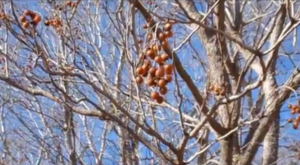Western Soapberry
Sapindus drummondii
 This picture was taken in January, and you’ll note the fruit is still firmly attached to the tree. They will only drop when the new season’s growth begins. This is probably an adaptation of the tree in drought-prone areas, where it is planted extensively.
This picture was taken in January, and you’ll note the fruit is still firmly attached to the tree. They will only drop when the new season’s growth begins. This is probably an adaptation of the tree in drought-prone areas, where it is planted extensively.
The Western Soapberry is a very adaptable tree that grows in hot, dry climates. It also grows well on limestone and is very drought-resistant.
There are plenty of things you can do with this tree too:
- Soap
- Medicine
- Shade and Shelter
- Tools and Weapons
This is truly a gem of a tree!
Soap – The fruit is loaded with sapinins, so you can crush the berries and agitate with water to make your own primitive laundry detergent. Really easy, but be careful as this could cause an allergic reaction in some folks.
Medicine – I have read that the Kiowa Indians in my area used this as a poultice for wounds. Do NOT eat this fruit.
Shade – I almost always see these growing in dense clusters and they make a welcoming canopy of shade in the hottest months. It is easily 10-20 degrees cooler under these canopies. A fellow could shelter himself against winter elements in these stands of Western Soapberry, too.
Shelter – Whenever you find this tree growing in clusters, like many species, you’ll have ready access to long and fairly straight poles for shelter-building although, admittedly, it will curve and bend a little more as hardwoods tend to do. A nice grove of these makes a great place to hang a hammock in the hot summer months. You’ll have fresh, green grass below your feet and a low, shady canopy overhead.
Tools – I absolutely love this wood for tools and tool making. This is where I think the Western Soapberry really shines. This makes the best tomahawk handle replacement wood for the weight and strength in my opinion. Think Bois d’arc without the weight and difficulty in carving. The grain pattern is very tight, and these trees don’t check and crack as bad as other species which is a good thing for the woodcrafter. I’ve used this wood for a take-down buck saw frame, firesteel handle, impromptu scales for a psk knife, and a tomahawk handle. I’ve used this wood for the bow of bow & drill fire kits, tarp stakes, crane suspension/pot suspension, tripods and a few other camp furnishings.
I’ve read of the young saplings making great arrows and arrow fore-shafts as well as a couple of bows made from this wood. All in all it’s a great tree for all around Bushcraft use. If you don’t have this tree natively in your area, they make for an inexpensive and fast growing addition to any homestead or landscape.
Google


4 Responses to THE COOLEST TREE YOU’VE NEVER HEARD OF